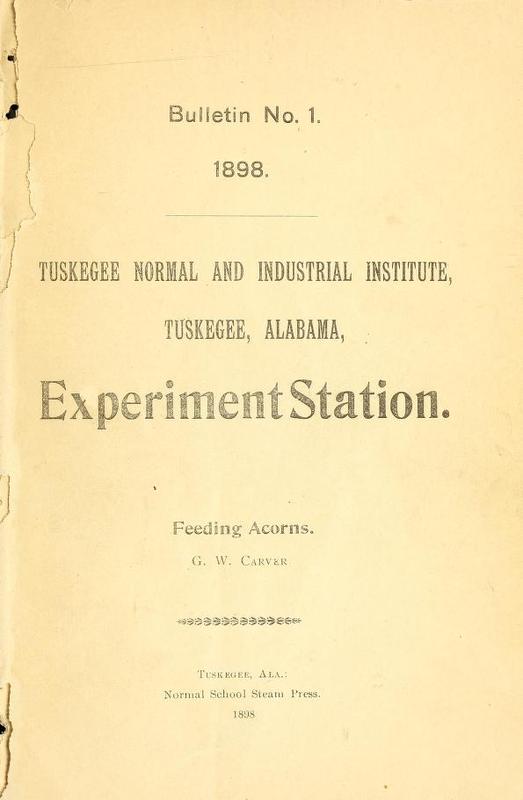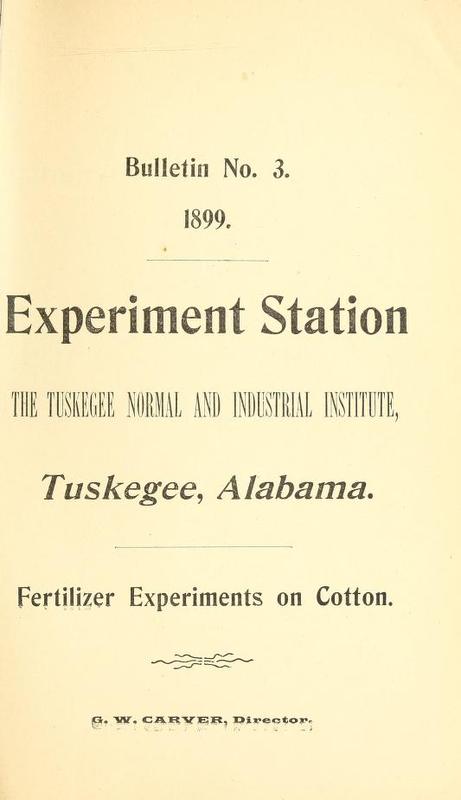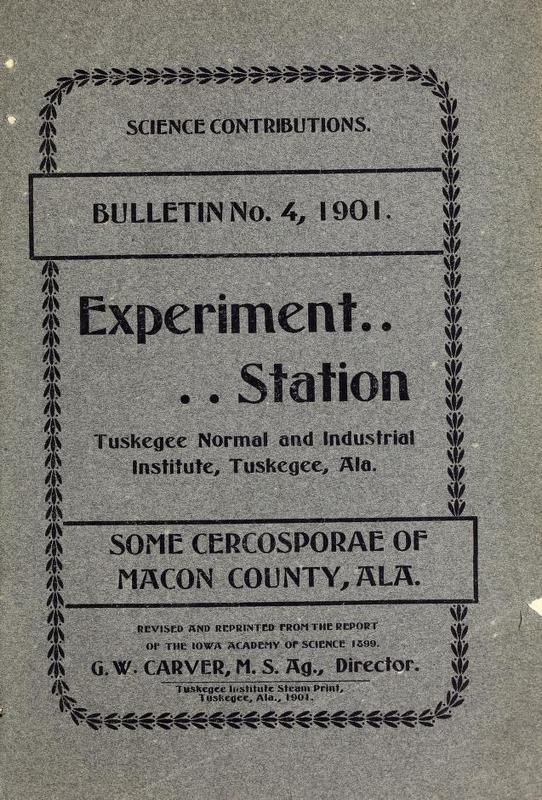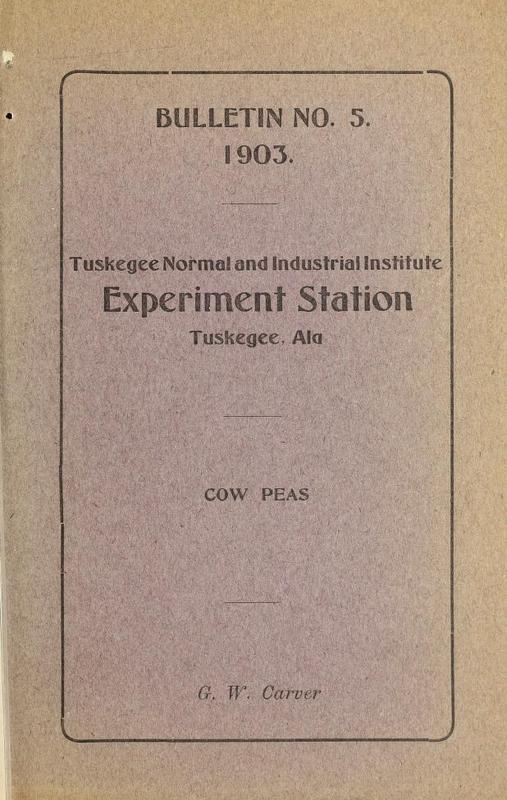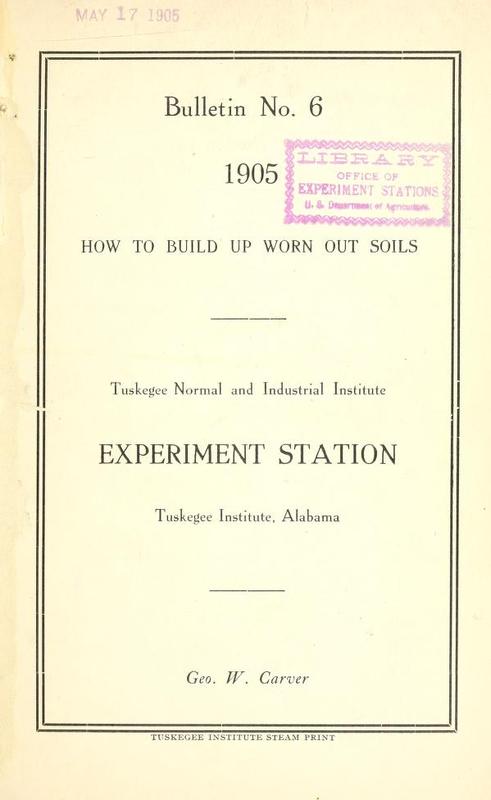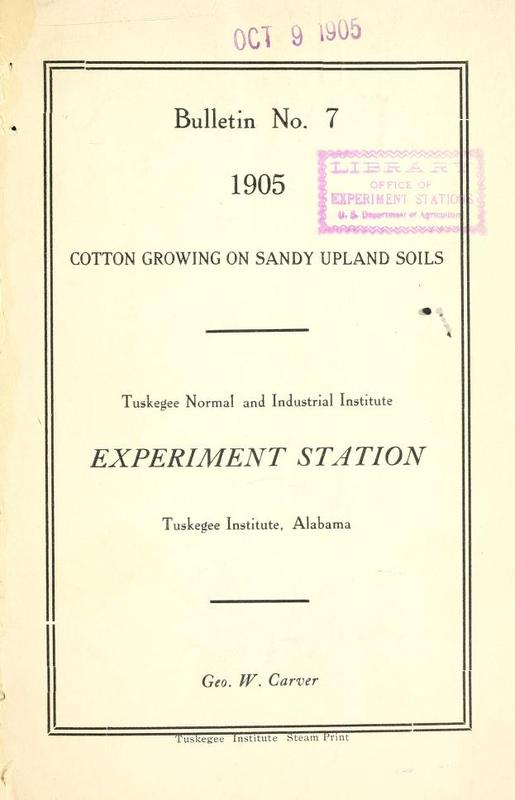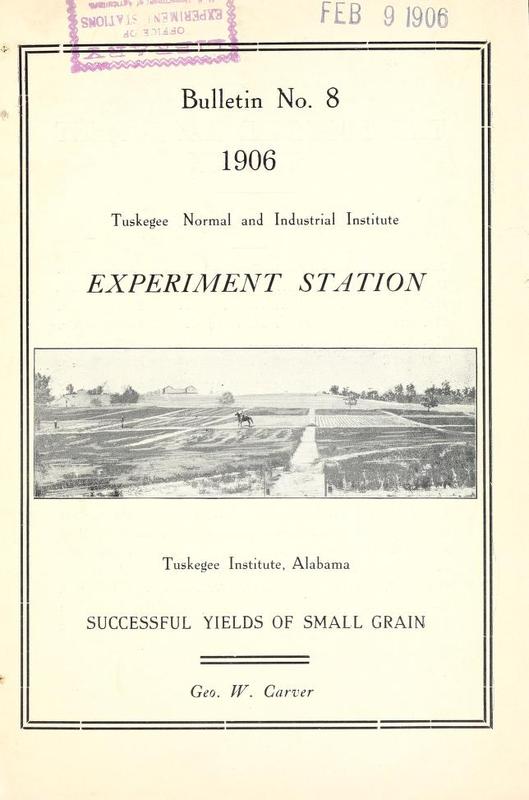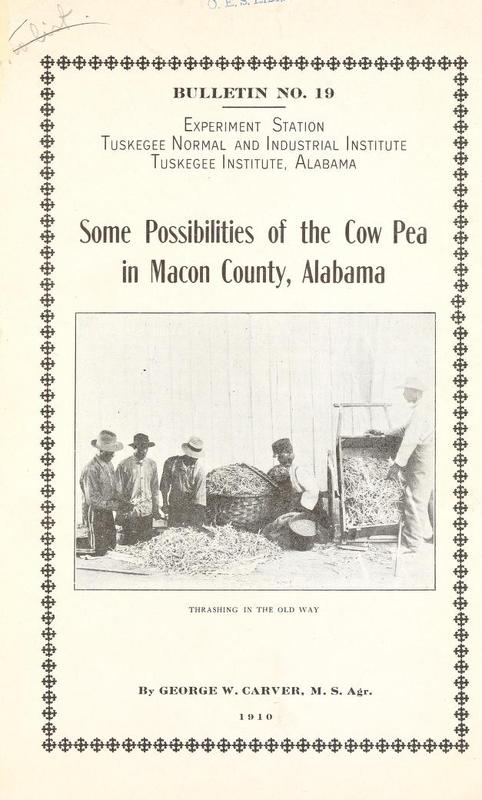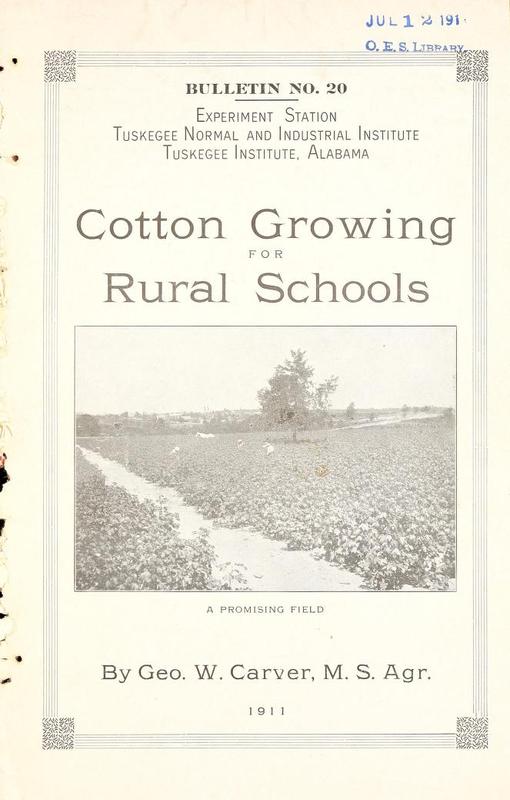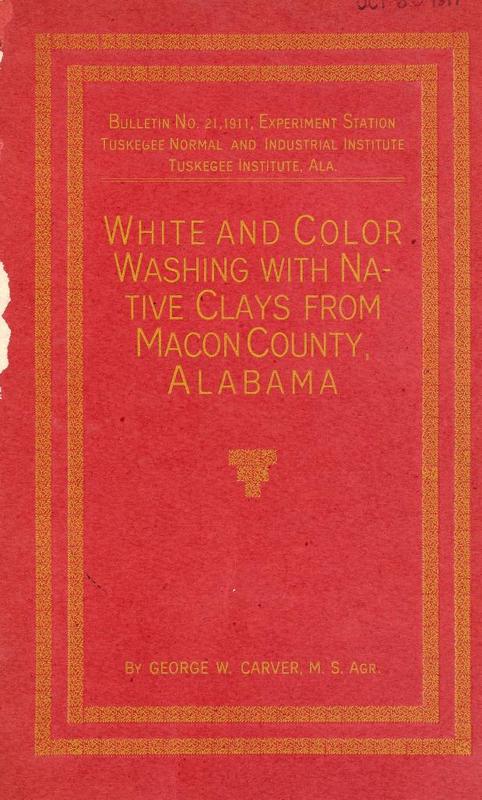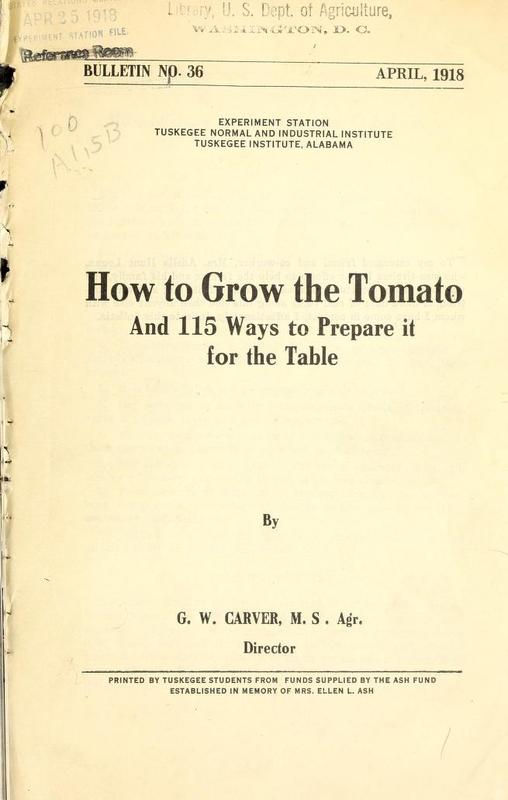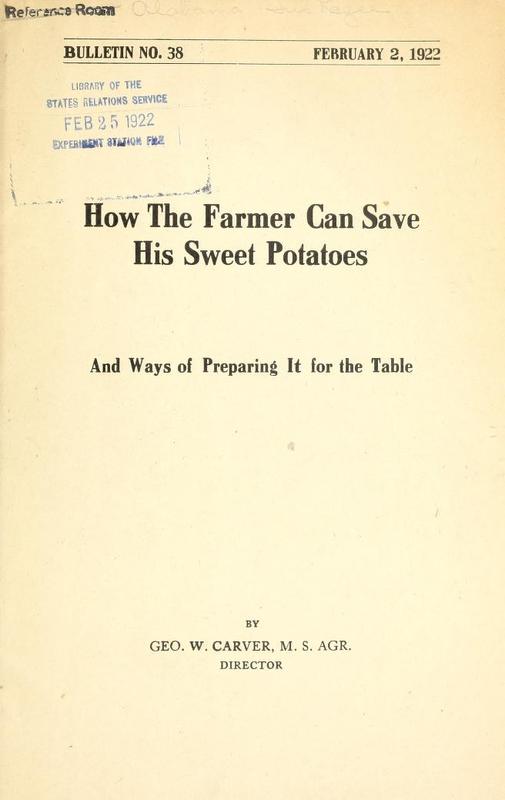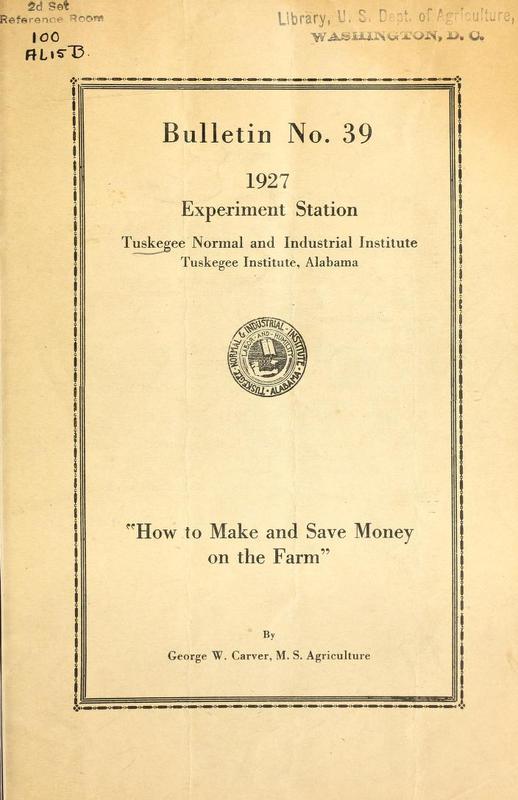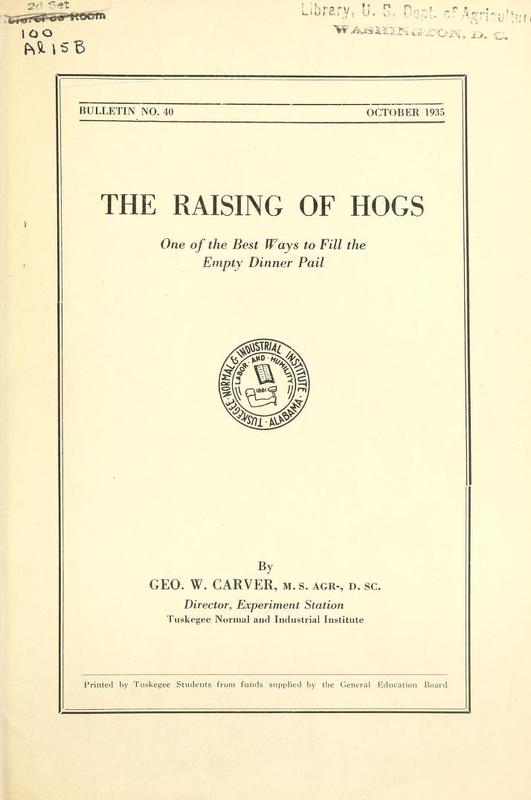George Washington Carver's Tuskegee Institute Experiment Station Bulletins
[M]ost of the Tuskegee [experiment] station bulletins tended to offer more practical advice for poor farmers than similar publications issued by other stations. By the time Carver published the station’s sixth bulletin in April 1905—titled ‘How to Build Up Worn Out Soils’—he could rightly assert ‘The Tuskegee station has…[kept] in mind the poor tenant farmer with a one-horse equipment; so therefore, every operation performed has been within his reach.’ Over the next fifteen or so years, the institute issued roughly twenty-five more bulletins, all but four of which were written by Carver.
Hersey, M. (2006). Hints and suggestions to farmers: George Washington Carver and rural conservation in the south. Environmental History, 11(2), p. 250. Retrieved from: https://www.jstor.org/stable/3986231.
This exhibit showcases the 38 Tuskegee Institute Experiment Station Bulletins held by NAL that were written by George Washington Carver during his tenure as Director.
To learn more about the subjects of the Bulletins, please explore one or more of the subexhibits.
(Click any image to access more information including full text)
"In this beautiful Southland of ours, with so many natural resources, and the repeated failures of the North, East and West to supply the ever-increasing demand for pork, dairy products, etc., has led us to turn much of our attention in this direction.
The great quantity of acorns produced in our oak forests, which have been hitherto practically a waste product, forms the subject of this Bulletin.
I presume that acorns have been used as an article of food ever since their production and that of the animals to eat them, and man has used them in a half-unconscious way, from the time America’s first settlers recognized the food value of the wild hog.
It did not take these sturdy colonists long to learn that the meat of the wild hog was fattest and sweetest when the mast (or acorns) were plentiful, as they were then and are now frequently called."
"In summing up and drawing conclusions from this experiment, I think it quite safe to conclude that, with the proper management, 500 bushels of sweet potatoes can be produced on one acre of our ordinary potato soils ; since 266 bushels were produced under the following trying conditions:
First — Abnormally poor soil, physically, mechanically and chemically.
Second — Owing to unavoidable reasons, the fertilizers could not be applied at the right time, which decreased the yield.
Third — The plants were set quite three weeks late.
Fourth — The potato crop was practically a failure almost all over the entire South; the average yield in this section being about 87 bushels per acre."
"The cotton fertilizer experiments made in 1898 are a continuation of a series of fertilizer soil tests commenced in 1897. The soil of the experimental field, a part of the station farm, is a light and sandy upland, with yellow clay subsoil.
The soil selected is excellently adapted for experimental purposes, having formed part of an old field which has been planted by the wasteful methods of the tenant system, year after year, for a long period. The soil was thoroughly “worn out’' as to its supply of fertilizing substances, nitrogen potash, and phosphoric acid, and was also in very bad physical condition. Its humus had long since been totally worked out and the top soil was very thin and with very little power to retain moisture. Even cow-peas failed to make a fair growth, on this soil before these experiments were begun, which is a pretty sure sign of a soil practically exhausted."
"The wide distribution and the economic importance of the Cercospora in this county has prompted the writing of this paper. This list by no means represents all of the species of this county, as no special effort has been made to collect Cercospora only. These collections were made while passing to and from other duties. With few exceptions, the species were collected in the immediate vicinity of Tuskegee.
The exceedingly warm and humid atmosphere, together with the very remarkable fluctuations of climate and rapid development of fungus diseases under these favorable conditions, has made the study doubly interesting. It is quite apparent that from year to year, by careful co-operation, much valuable information will be brought to light. None of our imperfect fungi have been worked over more carefully than the Cercosporeae. I have consulted the following works, Ellis and Everhart, whose work includes all of the North American species known to them when their work was written. Kellerman and Swingle for the descriptions of several new species. There are also descriptions of other species in the same journal."
"Every year the demand for an increased quantity and better quality of nutritious forage for animals, and a wider range of food stuffs for man has suggested a basis for some very careful and interesting study. Experiment Stations, as well as individuals, have devoted much time and means to this line of investigation. Plants of many different genera, species and varieties have been brought from India, China, Japan, Russia and other places. Many of these have proven worthless, while a few were of local importance only, still others are being tested with a considerable degree of promise.
Before we can appreciate the cowpea, or any of the legumes (pod-bearing plants), it is quite necessary that we fix clearly in our minds the following four laws of the great German chemist, Justus Von Liebig, with reference to soil fertility:
First. A soil can be termed fertile only when it contains all of the materials requisite, or necessary for the nutrition of plants in the required quantity and in the proper form.
Second. With every crop a portion of these ingredients is removed. A part of this portion is again added from the inexhaustible store of the atmosphere; another part is lost forever if not restored by man.
Third. The fertility of the soil remains unchanged if all the ingredients of a crop are given back to the land. Such a restitution is effected by fertilizers.
Fourth. The fertilizers produced in the course of animal husbandry are not sufficient to maintain permanently the fertility of a farm; it lacks the constituents which are annually exported in the shape of grain, hay, milk, and livestock.
In connection with the above facts, every progressive farmer recognizes that certain crops exhaust or make his soil poorer, and certain others build it up or make it richer. He is also aware that a better crop follows a pod-bearing one, such as peas, beans, clovers, vetches, peanuts, etc.; therefore, they are absolutely indispensable in a wise crop rotation, and in the rational feeding of both man and beast."
"The subject of soil improvement through natural agencies has been one of much concern to both ancient and modern agriculturists.
The ancient Egyptian knew that if he let his land lie idle, (rested) as he termed it, he was able to produce a much better crop, and that crop would be in quantity and quality, all other things being equal, proportionate to the length of time this land had been rested.
At a later period the fertilizing value of legumes (pod bearing) plants was recognized, but as the population of the world increased and civilization advanced, it became imperative that all farming operations should become more intensive and less extensive.
Each decade saw the progressive farmer slowly but surely moving on his journey of progress, correcting many mistakes of the past.
He then began to see that it was quite possible and practicable to keep his ground covered with some crop, and the soil become richer and more productive every year, by reason of this constant tillage — than was possible under the old and extravagant method of letting the land lie out idle for a few years.
“As science shed light upon his art,” he learned that chemical analysis of the soil, alone (though skillfully done) did not accurately determine the crop-yielding capacity of the soil, and that the greatest good would result only when such analyses were followed by carefully conducted field experiments. From these he learns further that the crop-yielding power is increased by rotating or changing his crop every year, or every few years upon land not occupied by such crop the year previous.
For eight years the Tuskegee station has made the subject of soil improvement a special study, emphasizing the subject of crop rotation, deep plowing, terracing, fertilizing, etc., keeping in mind the poor tenant farmer with a one-horse equipment; so therefore, every operation performed has been within his reach, the station having only one horse."
"This bulletin, in some degree is a continuation of No.6, on Soil Building, and emphasizes rather emphatically the possibilities of such soils in the production of cotton.
We have maintained that every acre of land in Alabama capable of being grown in cotton, could and should be made to produce at least one bale to the acre. The experiment further shows the value of selecting good seed and of a variety best suited to the locality in which it is to be grown.
THE SOIL AND ITS PREPARATION
The soil upon which these experiments were made is light, sandy, and constitutes the original poorest section of the experimental field.
Cow peas were grown upon these plots during the summer of 1908; the dry peas picked and the stubble turned under with a Boy Dixie turning plow, by going twice in the same furrow. September 20, one hundred pounds each of acid phosphate and Muriate of potash was mixed with ten tons of barn yard manure and muck from the swamp, mixed half and half, and harrowed in thoroughly with a spring tooth harrow. Wheat, oats, rye, vetch, etc., were sown for grazing. It made an excellent growth; it was grazed off, allowed to get two or three inches high and plowed under.
A very low bed was thrown up, opened, and the fertilizer (which consisted of the same kinds and quantity used for the small grain) was put directly into the furrow and the seed planted upon it, covering the same with a scooter. The seed were all planted April 22, and fertilized as per above, unless otherwise stated."
"This bulletin, also, is a continuation of 6 and 7 and endeavors to thwart the very prevalent idea that small grain cannot be profitably raised in this section.
THE CAUSE
It is just as applicable to apply the cause and effect rule to every operation of the farm as to the various branches of mathematics, there being no cause without an effect and no effect without a cause. So therefore upon this hypothesis we began our investigations.
Some time was spent in riding about over the country, studying the various large and small patches of grain here and there, noting their growth, resistance to heat, cold, drought, attacks of fungus diseases and insect enemies.
FOUND
The following was very noticeable:
(a) That no barley, but very little rye and wheat were sown as a full grain crop.
(b) The rye rusted badly, being literally red with rust early in the spring before it began to boot. It made poor grazing — not eaten by stock unless forced to do so.
(c) That in places the crop remained poor and produced only a small percentage of a crop.
(d) That wheat was badly affected with loose smut, (ustilago segetum) and Bunt or stinking smut, (Tilletia foetens). Oats also rusted and smutted badly."
"Of the many vexing problems with which the Southern farmer must deal, there are probably none more troublesome than the saving of his sweet potato crop.
Some years, all methods, from the simplest to the most complex, seem to succeed. Probably the very next year just the reverse is true, and all spoil, leaving in many instances hardly enough for seed.
The above conditions have been made the subject of investigation by our station, covering a period of five years, and we submit the results with a considerable degree of satisfaction, as we feel that certain facts have been brought to light, which, if observed, will render the successful saving of this crop much less problematical.
OBSERVATIONS
Much time was spent in riding over the country to ascertain just how the farmers kept theirs. They bank in the old-fashioned way almost universally. Some said they would not keep if planted in a certain kind of soil. Our investigations showed there was but little, if anything, to support such a statement. Others declared they would not keep unless planted, dug and banked on such and such a time of the moon. This, like the above statement, was proven false. Several other infallible methods were investigated, but suffered the same fate (disappointment) as the others to which I have referred.
It was observed, however, that the potatoes dug and banked after a long dry period, as a rule, kept well, while those dug and banked after, and during a rainy season, almost, without exception, kept poorly.
It was further observed that if potatoes were cut or broken, and the milky juice turned a dark greenish color after being exposed to the air until dry, they would keep poorly; but the juice dried white and the cut place showed a tendency to heal over, they invariably kept well.
Feeling that sufficient information had been secured to furnish material for an intelligent line of investigations, we therefore, began by examining (microscopically) a large number of potatoes, such as we have described."
"Nature endows or blesses each state or section with an indigenous flora and fauna best suited to that particular soil and climatic conditions.
Applying the above to Alabama, Macon and adjoining counties have been unusually blessed in the quantity, variety and quality of its wild plums.
They vary in size from a half to one inch in diameter, and in flavor from sugary sweetness to sour and bitter. In color, from lemon yellow to crimson, scarlet and black, making possibilities for many pleasing combinations for the eye and palate.
I feel safe in saying that in Macon County alone there are many hundred bushels of plums that go to waste every year that there is a full crop, which is almost one year with another.
In a commercial way there is a great opportunity for jam and jelly factories.
No fruit improves with cultivation more satisfactorily than the wild plum, both the size and flavor is improved, and under cultivation some of the yellow and red types compare favorably in size with the Wild Goose and other cultivated varieties of that class.
No fruit makes more delicious jams, jellies, preserves, marmalades, etc., and it is the purpose of this bulletin to set forth in a practical way a number of recipes by which every housewife may be successful in the saving of this splendid article of food."
"Since the publication of this bulletin the applications for it have steadily increased until the output of 1,500 has been exhausted and the demand unsupplied; and with this apology it was thought wise to republish it.
The popularity of the cow pea is increasing from every point of view from year to year. Someone has wisely said that as a crop, cow peas are to the South what clover is to the North, and alfalfa to the West. And we trust that the time is not far distant, when, as an article of human food, the pea itself will be to the South what the Boston, Navy and White soup beans are to the East and West.
In 1889 South Carolina produced 698,281 bushels. In 1899 1,162,705 bushels, which represents an increase of 66.5 per cent. Georgia, in 1889, produced 274,670 bushels. In 1899, 1,130,441 bushels, an increase of 16 per cent. North Carolina increased its output during the same period of years to 100.4 per cent. Alabama, 103 per cent.; Florida, 126.3 per cent.; Mississippi, 132 per cent.; Kentucky, 883.9 per cent.; Virginia, 1,003.2 per cent.
The average yield per acre in 1899 varied as follows: Maximum, 28.5 bushels, minimum, 6.8 bushels. The above increased percentage of yield in the various states indicate that the farmers are beginning to appreciate in a tangible way the value of this crop."
"Two years of cotton experimentation have come and gone since the issue of Bulletin 7 of this station, on Cotton Growing on Sandy Upland Soils; in that bulletin we took the position that every acre in Alabama capable of growing cotton , could and should be made to produce a bale of cotton to the acre.
The bulletin further shows that the above position was correct as it not only produced a 500-pound bale but 20 pounds in excess.
The years of 1906 and 1907 were such trying ones, and the output of cotton so satisfactory that we feel that it will be of special interest to every farmer to know just how it was done. Since the same laws which govern the successful production of cotton apply with equal force to other field and garden crops, we call attention to the following things of importance:
PREPARATION OF THE SOIL
In this it is safe to say that fully two-thirds of our farmers fail, they fail first, because they do not turn (broadcast) their land in the fall just as soon as the crop is off. Second, they do not plow deep enough."
"When we consider that Alabama alone cultivated, in 1907, 2,961,000 acres in corn with an average of only 15 1-2 bushels to the acre, it at once becomes apparent that something must be done to bring up this unfortunately low yield per acre. It is further accentuated from the fact that within the last ten years the average has never been higher than 16 bushels in 1906 and fell as low as 8 2-5 bushels in 1902.
While it is true (that Alabama soil and climate are particularly adapted to cotton, under proper management in the matter of the preparation of the soil, fertilizing, selection of seed and cultivation, very satisfactory yields may be produced.
Our Experiment Station has devoted much time to this important crop for both its grain and forage values.
In performing these experiments, we had to constantly keep in mind that we were dealing with a typical worn out soil, and that this soil must constantly grow richer instead of poorer, and at the same time must furnish a living for the farmer."
"There is probably no section of our country that furnishes more really beautiful and useful ornamental plants than this section of Alabama; indeed the landscape gardener and florist, alike can find flowers of rare beauty and fragrance, foliage unsurpassed in richness, and fruits, berries and other forms of seed capsules possessing a richness of color and gracefulness of form, which well nigh approaches the ideal in beauty and grace.
And the plants yield readily to the fastidious tastes of the master of form and design, also from the simplest to the most elaborate color schemes as fancy dictates.
It is a source of regret that we do not recognize and appreciate what Nature has so lavishly provided for us.
Every park and dooryard should contain just as many of these lovely native trees, vines, shrubs, etc., as fancy and good taste suggest."
"If there is one crop more than another, that Macon County can produce year by year and with almost unerring certainty, it is the sweet potato crop.
Now what is true of Macon County is true of the adjoining counties, and is more or less true of the entire South.
HISTORY
It is said that the early navigators of the sixteenth century recognized such a strong resemblance between the Irish potato and the sweet potato that they called them both by the same name.
They are not only different botanically, but the edible parts of each are in character and taste quite unlike.
Botanically, the sweet potato belongs to the morning glory family (Convolvulaceae), and has been given the technical name of Ipome abatatas.
ORIGIN
The origin of the sweet potato is doubtful, although there is very strong evidence that it is distinctly American, as fifteen or sixteen known species of the genus Batatas are found in this country. The ‘Indian potato,’ ‘Tuckahoe’ and ‘Hog potato,’' which grow abundantly in this country and throughout the South, are all species of this genus.
VARIETIES
More than 100 so-called varieties make up the present list, many of which there is a distinction without a well-defined difference.
Since some varieties do well in one section and practically fail in others, I have thought wise to list none except those that have proven the most prolific and best with us.
TABLE VARIETIES: Dooley Yam, Improved Dooley Yam, Triumph and Pumpkin Yam.
VARIETIES FOR FEEDING STOCK: These grow to a very large size and make a fine yield, but are not very sweet and rather inferior for table use— White Bermuda, Red Nansemond, ‘Negro Choker’ and Hayti Spanish."
"Since the publication of Teachers’ Leaflet No. 2, Nature Study and Children’s Gardens, the work has not only grown in a satisfactory manner, but has advanced far beyond the most sanguine hopes of its promoters — indeed the 1,500 copies of this leaflet which was published in 1904 have been exhausted without satisfying the increasing demand.
The above facts in connection with a careful study of the needs of the rural teacher, we have thought wise to revise and amplify it, bringing the same more up to date.
The chief mission of this little booklet is that of emphasizing the following points:
1. The awakening of a greater interest in practical nature lessons in the public schools of our section.
The thoughtful educator realizes that a very large part of the child’s education must be gotten outside of the four walls designated as class room. He also understands that the most effective and lasting education is the one that makes the pupil handle, discuss and familiarize himself with the real things about him, of which the majority are surprisingly ignorant.
2. To bring before our young people in an attractive way a few of the cardinal principles of agriculture, with which nature study is synonymous.
If properly taught the practical Nature study method cannot fail to both entertain and instruct.
It is the only true method that leads up to a clear understanding of the fundamental principles which surround every branch of business in which we may engage. It also stimulates thought, investigation, and encourages originality."
"The cow pea is rightfully looked upon by many as the poor man’s bank or mortgage-lifter. I think I am safe in the assertion that there is no crop grown in the South which possesses so many good qualities and is so easily grown as the cow pea.
It is a matter of much regret that every colored farmer in Macon County does not plant at least three acres in peas.
In 1902 the entire state planted only 91,126 acres in peas, and produced the surprisingly small amount of 665,388 bushels — just a trifle above 7 bushels per acre. The yield should not have fallen below 1,822,520 bushels.
It is interesting to note that, for the last 15 years, cow peas in this country have sold, in the spring, at a high price. The prices this year (June 11th) ranged from $2.50 to $3.00 per bushel and they were exceedingly difficult to get at these prices, because the farmers did not have them. With a little attention the pea can be made to yield far better returns, all things considered, than cotton. The colored farmers alone in Macon County ought to produce with the greatest of ease, 125,000 bushels of peas and many thousand tons of valuable hay.
History
For nearly one hundred years the cow pea has been the chief leguminous (pod-bearing) crop throughout the entire group of Southern States. About fifty varieties have been cultivated to a greater or lesser extent in the United States, and every year its value is becoming better known and more highly appreciated, as is evidenced by the increased acreage planted wherever it can be grown."
"There is doubtless no plant more interesting to the casual observer, or more useful economically and more wonderful to the searcher for truth than the cotton plant. It forms the principal products of eight great states of this Union. It also has an ancient history. It is said to have been grown and manufactured into clothing over 2,500 years ago. The early Greek historian, Herodotus said of the fiber, 'that it was of better quality and finer than that of wool.'"
"Of the many attractive features of our beautiful county, I think there is possibly none that elicit such universal admiration and praise as the vast deposits of multi-colored clays, ranging from snow-white, through many gradations, to the richest Sienna and Indian reds on the one hand, and from the deepest yellow ochre to the palest cream tintings on the other.
We have never looked upon our county as possessing vast mineral wealth; nevertheless, this is true, in her rich deposits of clay.
It is well understood that brick of superior quality and richness of color can be made. Now and then a jug factory springs up here and there, makes a few wagon-loads of jugs, churns, jars, crocks, vases, and flower pots, sells them out and disappears as mysteriously as it came; thus, slowly but surely, the value of these splendid clay deposits becomes known.
The materials for the manufacture of pressed brick, drain pipe, pottery, and fine kaolin wares are here in abundance."
"Of all the get-rich-quick schemes there is probably none more productive of delusion than that of poultry raising on paper. And yet, with the proper facilities and applied intelligence, possibly more handsome returns can be had from poultry than any other industry in proportion to the amount of capital invested and the readiness with which results can be obtained.
There is an idea prevalent that poultry cannot be successfully raised in the South. This saying has been so oft repeated and the apparent truth so universally verified that the majority of our people believe it and make but little or no effort to prove it false.
Years of costly experimentation and investigation have improved many of the apparent unsurmountable obstacles, so that there remains no doubt as to its possibilities. It is therefore the purpose of this bulletin to set forth, in as clear and concise a way as possible, a number of rules and suggestions which, if carried out, will enable an amateur to successfully grapple with this problem.
It is hard to conceive of a great state with 223,220 farms, aggregating 20,685,427 acres, with a grand total of only 5,186,536 fowl of all kinds and ages upon these farms, which would mean, in round numbers, 23 fowl to the farm, or about 4 fowl to the acre."
"Many and varied are the methods of curing and otherwise preserving meat in the fall and winter months when the weather is cold enough to insure success.
All the methods examined were successful and some of superior merit, but the notion of killing and preserving meat in hot weather had scarcely been given a thought; “impossible” seemed to have been written across the face of any such proposition. However, two great problems demanding a solution seemed to be ever before us.
The entire South has been slow in the matter of pork production for the following reasons: First, the feedstuff for fattening hogs is especially plentiful in summer; the hogs grow off and fatten rapidly; they soon reach the killing point, and become a loss in dollars and cents, besides having other disadvantages whenever an attempt is made to carry them over till cold weather. Second, cholera, which rarely fails to make its more or less destructive appearance in the fall, seems to be especially partial to fat hogs.
I think possibly that these two things have done more to keep the South from being a great pork-raising center than all the others combined. With this situation before us, a pickling solution seemed the most feasible; so, therefore, we set about to find one.
A large number were found for the corning or pickling of beef, but those for pork were rather meager; but by taking those available in this and other countries, particularly those found in the United Kingdom of Great Britain, Ireland, Denmark, Holland, Scotland, England, and Canada, I was able to work out the following which has worked admirably with us."
"LOCATION AND BOUNDARIES
Macon County, 'the garden-spot of Alabama,' lies near the eastern boundary of the State, about 135 miles north of the Florida-Alabama line. It has an area of 621 square miles, embodying 397,440 acres. It is 34 miles in extent from east to west, and 24 3/4 miles from north to south. The northern and western boundary lines are quite irregular.
COUNTY SEAT
Tuskegee, the county-seat, was laid out in 1833, and has grown steadily since the removal of the Indians in 1836. It is located in the north central part of the county, and is noted for its commanding location, beautiful surroundings, and the purity of its waters. Indeed, mineral water of no mean composition has been found here and there within its borders.
HISTORY
Macon County was named in honor of the illustrious North Carolina statesman, Nathaniel Macon, and was established as a county December 18, 1832, by act of the General Assembly of the State of Alabama."
"Sixteen years ago the Experiment Station undertook the production of a type of cotton that would possess the following characteristics:
1. A longer and finer staple.
2. A more prolific variety.
3. A disease resistant variety.
4. A cotton that produces well on light, sandy soils.
5. An early maturing variety that would escape more or less the ravages of the boll weevil.
In all the above matters a marked degree of success has been obtained.
TUSKEGEE EXPERIMENT STATION
This cotton has the following well-known types carefully bred into it: Sea Island, from whence it gets its long, silken fiber; Russell’s Big Boll, from whence it gets its large bolls, and its adaptability to upland conditions of soil and climate; Jackson’s Wilt Resisting, from whence it gets its power to resist to a remarkable degree the troublesome diseases known as wilt, black root, etc.; Simpkin’s prolific, from whence it gets its great fruiting habit."
"There is without doubt no activity connected with the farm or garden of greater importance than the canning and preserving of fruits and vegetables. The following are some of the strongest arguments in its favor:
1. It is the easiest, cheapest, quickest, and best method yet devised by which we can have plenty of good, wholesome fruits and vegetables at a time when the fresh article is out of season.
2. Fruits and vegetables can be preserved, dried, and canned that otherwise would go to waste, such as that which is below marketable size, lop-sided, specked, or deformed in other ways.
3. There is always a market for choice, home-canned goods, and many are the quarters, dimes, and nickels that can be taken in in this way.
4. It is a noticeable fact (all other things being equal) that those who partake freely of fruits and vegetables every day have the clearest minds and the strongest and healthiest bodies.
5. With plenty of fruits and vegetables in the pantry or cellar, there is absolutely no excuse for suffering from hunger. It is astonishing how it cuts down the cost of living.
It is estimated that fully two-thirds of our fruits and half our vegetables go to waste every year, which, if canned, preserved, or dried, would furnish nutritious and palatable dainties sufficient to last throughout the winter and spring months."
"For many years we have been testing in one way or another almost every variety of legume that seemed in the least promising, with the view to finding one or more that would succeed in this section and give us a permanent pasture without having to prepare and re-seed the ground each year.
Alfalfa has really gone beyond the high standard set by its enthusiastic admirers, and has in a remarkable way convinced the most skeptical that it can be grown on sandy soil.
Location and Soil
In character the soil is a light-gray, sandy, upland, free from lime, under laid with red and yellow mottled clay, which crops out here and there on the surface. The sand content ranges from 75 to 80 per cent, and is just the kind of soil upon which time-honored custom says alfalfa will not grow.
The Beginning
Early in the summer of 1911 the land was broadcasted with 8 tons of barnyard manure to the acre; plowed to a depth of 9 inches, and sowed in cow peas, which made a heavy growth of vines and an excellent crop of peas. The vines being too heavy were grazed off by the cows, re-manured with 5 tons of barnyard manure to the acre, 5 tons of caustic lime (air slaked), and 5 tons of crushed lime rock per acre. These were plowed in and harrowed thoroughly."
"As we learn more about ourselves and the relation of food to our well being, we cannot but agree with those who have made it a study that ‘the prosperity of the nation depends upon the health and morals of its citizens, and the health and morals of a people depend mainly upon the food they eat, and the homes in which they live.’
As a rule, we are wasteful; we do not know how to save. Ignorance in the kitchen is one of the worst curses that ever afflicted humanity, and is directly or indirectly responsible for more deaths than all the armies combined. It sacrifices human life from the following angles:
1. A poor selection of food; that is, foodstuff lacking in the constituents necessary to build up the body and keep it healthy.
2. Bad combinations of food; that is, there are many foodstuffs good within themselves, but when combined with other material create an unnatural appetite; and quite frequently the body is unnourished, unduly stimulated, and as a result often leads to strong drink, bad morals, and bad manners.
3. Bad preparation of food. In this I think I make a conservative statement when I say that 75 per cent of those who are entrusted with this important charge are deficient. Here is the very hot-bed for indigestion, constipation, sour stomach, malnutrition, colic, and a host of other stomach troubles."
"Of all the money crops grown by Macon County farmers, perhaps there are none more promising than the peanut in its several varieties and their almost limitless possibilities.
Of the many good things in their favor, the following stand out as most prominent:
1. Like all other members of the pod-bearing family, they enrich the soil.
2. They are easily and cheaply grown.
3. For man the nuts possess a wider range of food values than any other legume.
4. The nutritive value of the hay as a stock food compares favorably with that of the cow pea.
5. They are easy to plant, easy to grow and easy to harvest.
6. The great food-and-forage value of the peanut will increase in proportion to the rapidity with which we make it a real study. This will increase consumption, and therefore, must increase production.
7. In this country two crops per year of the Spanish variety can be raised.
8. The peanut exerts a dietetic or a medicinal effect upon the human system that is very desirable.
9. I doubt if there is another foodstuff that can be so universally eaten, in some form by every individual.
10. Pork fattened from peanuts and hardened off with a little corn just before killing, is almost if not quite equal to the famous Redgravy hams or the world renowned Beech-nut breakfast bacon.
11. The nuts yield a high percentage of oil of superior quality.
12. The clean cake, after the oil has been removed, is very high in muscle-building properties (protein), and the ease with which the meal blends in with flour, meal, etc., makes it of especial value to bakers, confectioners, candy-makers, and ice cream factories.
13. Peanut oil is one of the best known vegetable oils.
14. A pound of peanuts contains a little more of the body-building nutrients than a pound of sirloin steak, while the heat and energy-producing nutrients it has more than twice as much."
"It needs but little or no discussion to convince us that we are on the beginning of the most perplexing, most interesting, and the most important period of our lives.
We are confronted with new economic conditions; the problems of last year are not the problems of this year; yea, the problems of yesterday are greatly overshadowed by the problems of today; and even the wisest heads are slow even to conjecture what will be the result, and where coming events will cast their shadows."
"Nature endows or blesses each State or section with an indigenous flora and fauna best suited to that particular soil and climatic conditions.
Applying the above to Alabama, Macon and adjoining counties have been unusually blessed in the quantity, variety and quality of its wild plums. They vary in size from a half to one inch in diameter, and in flavor from sugary sweetness to sour and bitter. In color, from lemon yellow to crimson, scarlet and black, making possibilities for many pleasing combinations for the eye and palate.
I feel safe in saying that in Macon County alone there are many hundred bushels of plums that go to waste every year that there is a full crop, which is almost one year with another.
In a commercial way there is a great opportunity for jam and jelly factories.
No fruit improves with cultivation more satisfactorily than the wild plum; both the size and flavor is improved, and under cultivation some of the yellow and red types compare favorably in size with the Wild Goose and other cultivated varieties of that class.
In comparison with some of the standard fruits of the world as to food and dietetic value, one is at a loss to know why so valuable a fruit has been and is being so sadly neglected and allowed practically to go to waste."
"Among the many rich blessings especially given to the South, there are but few, if any, that stand out more prominently than the cow pea, for the following reasons:
1. It is a legume (pod-bearing plant), and brings fertility to the soil. In this it has but few equals, and still fewer superiors.
2. As a food for man and beast the peas are almost indispensable, and the vines make a very superior roughage for stock.
3. Year by year this splendid vegetable becomes more popular — the radius over which it is grown has steadily increased until there is scarcely a section of the country where farming is carried on to any considerable degree, that it may not be found in some one or more of its several varieties as forming one of the principal crops.
4. There are few crops grown by the farmer that has such a wide range of uses.
5. It is one of the easiest of farm crops grown, making a fair yield under absolute neglect.
6. It is the one sure crop the farmer can depend upon year after year if he plants two or more’ of the standard varieties.
7. In this locality fresh green peas may be had from the latter part of May until frost.
8. Thus far the demand has been far greater than the supply; hence, prices have always been good.
9. For green-manuring it is universally grown and admired.
10. When the running varieties are planted with corn, sorghum, etc., it makes a very superior silage, greatly relished by all kinds of stock.
11. The cow pea rightly handled is both a bank and a mortgage-lifter to the poor man.
It is a matter of much regret that every colored farmer in Macon County does not plant at least three acres in peas."
"But few people realize what an important vegetable the tomato is. While it is true that chemical analysis does not place it very high in the nutritive scale, if viewed from this angle alone its real value will be greatly underestimated.
For the reasons which follow, every normal person should make the tomato a very prominent part of the weekly diet:
1. It is a vegetable that is easily grown.
2. It yields well and keeps for a long time.
3. It usually brings a fair price, because nearly everyone likes tomatoes.
4. It contains distinct medicinal virtues (which are recognized by many authoritative books on household remedies), as “vegetable calomel.”
5. It is both a relish and an appetizer as well as a food.
6. Our soils can be made to bring enormous yields of tomatoes, superior in look, taste, and general appearance.
7. They can be prepared in so many delicious ways that one can eat them every day in the week and not get tired of them.
8. The old vines contain splendid dye-stuffs, which could be utilized as a by-product for dying fabrics of various kinds.
9. There as so many sizes, colors, and varieties that, for garnishings, fancy soups, and especially fine decorative table-effects, they are almost indispensable.
10. With a little intelligent effort fresh tomatoes can be produced in this locality almost the year round."
"SWEET POTATO FLOUR
There are several grades of this product and quite as many ways to manufacture them. Each one of these flours or meals (as most millers insist upon calling them) has a particular character of its own and is therefore adapted to certain uses the other products are not.
These Sweet Potato flours are generally speaking of three kinds.
1st. Those made from the uncooked potato.
2nd. Those made from the cooked potato.
3rd. Those made from a careful system of roasting, or from the starch making process. The first two will interest the housewife most, so, therefore, I will dwell almost or quite exclusively on these."
"There are but few if any of our staple farm crops, receiving more attention than the sweet potato, and indeed rightfully so. The splendid service it rendered during the great World War in the saving of wheat flour, will not soon be forgotten. The 99 different and attractive products (to date) made from it, are sufficient to convince the most skeptical that we are just beginning to discover the real value and marvelous possibilities of this splendid vegetable.
Here in the South, there are but few if any farm crops that can be depended upon one year with another for satisfactory yields, as is true of the sweet potato. It is also true that most of our Southern soils produce potatoes superior in quality, attractive in appearance and as satisfactory yield as any other section of the country.
HISTORY
It is said that the early navigators of the sixteenth century recognized such a strong resemblance between the Irish potato and the sweet potato that they called them both by the same name.
They are not only botanically, but the edible parts of each are in character and taste quite unlike. Botanically, the sweet potato belongs to the morning glory family (Convolvulaceae), and has been given the technical name of Impomeabatatas."
"Foreword
Bulletin No. 39 from the Alabama Experiment Station located at Tuskegee Institute under the direction of Dr. George W. Carver, is being issued at a very opportune time. The problem of farm management is becoming more and more serious every year. It is not that there is any falling off in production; in fact there has been a great increase in production in the last fifteen years. In practically every line America is today producing a surplus crop. The problem of farming, rather than the purely agricultural end, is more and more demanding attention. The farmer must learn how to organize his farm activities, and Bulletin No. 39 contains some sound and valuable information calculated to help the average farmer in this direction.
It will pay to read this bulletin over several times and then study it, and, if necessary, call in the farm demonstration agent for advice and counsel. Both the home demonstration agent and the farm demonstration agent will be glad to assist the farmer and his wife in putting these suggestions into effect.
Every dollar that the farmer saves by producing and conserving what he needs for his own living will be that much gain to him in the sale of his surplus. Dr. Carver is giving instructions that will reduce the amount of cash money that the farmer must spend, so that his cash returns from his crops will be pure gain.
I hope there will be the widest possible circulation given to this bulletin.
R. R. MOTON, Principal
Tuskegee Institute, Alabama,
August 10, 1927."
"With sugar cured hams selling for 26 cents per pound, bacon sliced selling for 36 cents per pound, lard selling for 19 cents per pound, and unsmoked white meat selling for 23 cents per pound, it does not require the wisdom of a philosopher to see that the bulk mass of dinner pails must remain only partially filled or entirely empty in so far as the above pork products are concerned.
The all absorbing question is:
(a) Can the above condition be remedied?
(b) Yes.
(c) In what way?
(d) By learning to raise pigs with little money.
(e) How can this be done?
(f) By studying and beginning at once to carry out the suggestions outlined herein.
(g) Every farmer must realize that the hog is one of the best mortgage lifters on the farm, and can be quickly and easily raised with but little or no cash outlay.
Extensive study leads me to believe that there is not a single spot or section in the entire South that is equal to, much less excel, the natural advantages found here in Macon County, Alabama, for the production of not only choice pork for home consumption but large quantities for market."
"I am confident that no other time has been more favorable than the present for every farmer in Alabama to think seriously and constructively along this line, asking himself the following questions. (I feel equally sure that with the facts before him he will have little or no trouble in deciding what course to take.)
QUESTIONS AND ANSWERS
No. 1. Is live stock necessary to successful farming?
Yes, absolutely. For centuries a good, well-cared for cow was recognized as half of any family’s living, by:
a. Furnishing all the milk, butter, cream, etc., the ordinary family, can use, and if properly cared for a surplus can be had to sell.
b. In addition to the above she should produce a calf every year.
c. According to Brooks, this cow will consume 25 pounds of dry matter per day, which means as a by-product, 96 pounds of manure daily, having an average composition per 1,000 pounds…
It is easy to see that our farm animals are great fertilizer factories, turning out the cheapest and best known product for the permanent building up of the soil. In addition to this farm yard manure there are also many' thousands of tons of the finest fertilizers going to waste all over the South in the form of decaying leaves of the forest and the rich sediment of the swamp, known as 'muck.' Every idle moment should be put in gathering up these fertilizers."
"Origin of Scientific Agriculture
One is not only surprised but astonished to learn that less than a century and a half ago, agriculture was without a scientific working basis. Credit goes to the great German chemist, Justus von Liebig for starting this revolutionary movement. The following four laws which form the foundation of modern agricultural practice were fully established by Liebig and should be studied and mastered by everyone attempting to deal with the fertility of the soil:
1. A soil can be termed fertile only when it contains all the materials requisite or necessary for the nutrition of plants in the required quantity and in the proper form.
2. With every crop a portion of these ingredients are removed. A part of this portion is again added from the inexhaustible store of the atmosphere; another part is lost forever if not restored by man.
3. The fertility of the soil remains unchanged if all the ingredients of a crop are given back to the land. Such a restitution is effected by fertilizers.
4. The fertilizers produced in the course of husbandry are not sufficient to maintain permanently the fertility of a farm; they lack the constituents which are annually exported in the shape of grain, hay, milk, and live stock."
"Since the article appeared in the Alabama Journal, Tuesday, February 10, 1942, by Mr. W. T, Maynor, captioned 'Don’t Worry If War Causes Shortage of Green Vegetables, Weeds Are Good To Eat' the large number of letters that continue to come in asking for more information makes us feel that here is an opportunity to render a service much needed at the present time, and equally applicable to our coming rehabilitation program.
COMPOSITE FAMILY
In the group idea in arrangement it is hoped that it will assist the housewife in the preparation of these vegetables as every member of a group (with but few exceptions) have some food or medicinal properties in common with the entire group, therefore, their preparation would be similar in some respects."
 An official website of the United States government.
An official website of the United States government.


